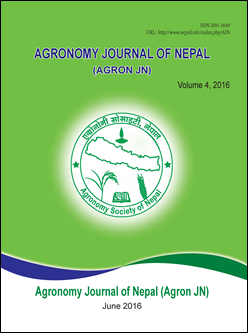Status of Methane Gas Emission from Paddy Fields in Nepal
DOI:
https://doi.org/10.3126/ajn.v4i0.15537Keywords:
Methane, Emission status, PaddyAbstract
Annual methane emission from paddy fields in Nepal has been estimated based on the published secondary data for 11 years from 2000-2010. Available data were collected from the Ministry of Agricultural Development (MoAD), Department of Agriculture (DoA) and Nepal Agricultural Research Council (NARC). Green house gas emission (GHG) was estimated by using IPCC 2006 guidelines. Agricultural activities contribute directly to emissions of greenhouse gases through a variety of processes including the source categories such as enteric fermentation in domestic livestock, livestock manure management, rice cultivation, and agricultural soil management. Diverse traditional agriculture systems, unique diversities in land types and unavailability of required disaggregated data at the national level as defined by the emission factor data base (EFDB) of the IPCC 2006, were the problem encountered while calculating the emission status in this study. Annual methane (CH4) emission from paddy fields ranged from 111.57 to 133.07 Gg over years 2000 to 2010 but it was found lowest ( 111.57 Gg) in the year 2002 and highest (133.07 Gg) in the year2003. In the year 2010, methane emission from paddy cultivation represented about 17.48 % of cumulative methane emission both from livestock sector and paddy fields throughout Nepal. Also, some relevant policies and potential strategies towards mitigation measures of methane gas emission from paddy fields for the future in Nepal are highlighted.
Agronomy Journal of Nepal (Agron JN), Vol.4, Page: 142-148, 2016
Downloads
Downloads
Published
How to Cite
Issue
Section
License
ASON permits for free use, distribution and reproduction in any medium if the original work is properly cited and not used for commercial purposes.




